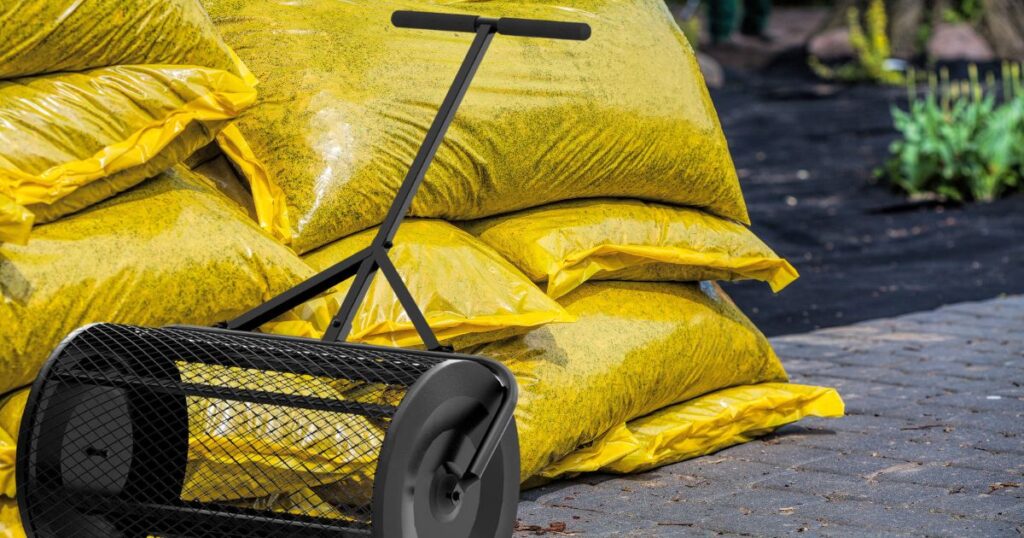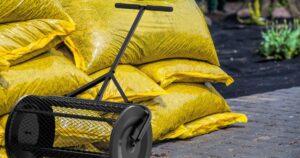
Best Compost Spreader: Top Spreaders For Your Lawn And Garden
A Horticulturist And Landscape Designer With Over 30 Years Of Experience Shares His Top Tips For Choosing The Best Compost Spreader For Any Size Lawn And Garden

Spreading compost in your home garden or lawn is one of the best things you can do for healthy soil. A uniform layer of compost supports plant growth, helps retain moisture, and encourages microbial activity.
But spreading compost by hand takes a lot of time, especially if you’re working with a large area. That’s where a good compost spreader comes in.
There are many types of compost spreaders, and not all of them are right for every situation. Some work well on smaller lawns, others cover a larger area more efficiently.
Knowing the size of your lawn, the type of grass, and the kind of compost you use will help you choose the right tool.
Best Compost Spreaders for Home Gardens And Large Landscape
These are the top models I recommend based on years of testing and working with clients across different types of gardens and lawns:
1. Landzie 24-Inch Compost Spreader
The Landzie lawn spreader is a popular model for good reason. It features a diamond-shaped metal mesh basket, air-filled tires, and an ergonomic handle. It’s ideal for small to medium lawns. The lightweight design makes it easy to push, and it handles clumpy materials well. Its consistent spread pattern gives better results with less effort.
2. Walensee 24-Inch Compost Spreader
Another good option is the Walensee compost spreader. It has a steel drum, upgraded T-shaped handle, and easy loading from the side hatch. This spreader is useful for lawns up to 10,000 square feet. The adjustable handle and compact frame offer easy storage.
3. Wefrib 24-Inch Compost Spreader
The Wefrib spreader is similar in design to the Landzie and Walensee models but often comes at a more affordable price. It performs well in spreading top dressing, compost, and even grass seed. It offers good value for home gardeners needing regular use without heavy-duty demands.
4. Loyal Manure Spreader - For Bigger Projects
This heavy-duty lawn spreader is designed to handle larger volumes. If you’re using aged manure or compost with a high moisture content, the Loyal manure spreader has the steel construction and spreading width to manage it. It’s a good choice for gardeners working with much material on large gardens.
- Up-front controls for apron-chain and beater
- Measures 28.6 cu. ft. (23 bu)
- 14 ga. galvanized steel box with flared sides/powder-coated, heavy-steel frame
- Pull-behind, ground-driven manure spreader
- Any 10+ HP garden tractor/ATV can pull
- Comes fully assembled and ready to go
- Easiest to operate
- 46-1/2 in. W; pull right to the stall
- Ideal manure spreader for 1-6 stalls
- Bear-claw beaters quickly shred/spread
- Spreads in approximately one minute
- Weight: 385 lb.
- Larger, heavier axle
- Stronger, A-frame hitch design
- Greaseable bearings and sprockets included
- Overall dimensions: 101 in. L x 40 in. H x 32-1/4 in. H (to box top)
- 1 year limited warranty
- Made in the USA
Why You Should Spread Compost
Spreading compost adds organic matter to your soil. This improves texture, increases water retention, and helps build a stronger root system. Whether you’re growing vegetables in a small garden or caring for a large lawn, compost can make a big difference. Compost also helps regulate soil temperature and reduce erosion.
Compost supports a natural soil structure that benefits lawns, flower beds, and vegetable plots. It introduces beneficial microbes that break down nutrients and support plant roots. For lawns, compost strengthens grass from the soil up, improving color and resilience. For gardens, it enhances flowering and fruiting.
If you’re starting a new lawn, adding compost during seeding will support early growth. For existing lawns, top dressing once or twice a year helps improve overall health. For garden beds, compost adds nutrients to support your flowers and vegetables all season long.
Best Times of Year to Spread Compost
Late spring and early fall are the best times to spread compost. The soil is warm, and plants are actively growing. This helps compost break down quickly and feed your plants.
In early spring, composting is helpful before planting vegetables or refreshing flower beds. The compost prepares the soil and enhances seed germination. In regions with mild winters, you can spread compost in late winter to get a head start on spring growth. In cooler zones, wait until the soil thaws and dries out enough for walking and working.
Fall composting is valuable for lawns. Spreading after your last mow and before the first frost strengthens grass roots and improves soil structure over winter. Avoid spreading compost in the middle of winter when the ground is frozen, or in the peak of summer when it may dry out too quickly.
Try to avoid rainy days. Compost should stay where you spread it, not wash away. Dry, cool days with light wind give the best results. Make sure your compost is dry and crumbly when you spread it—clumpy materials may clog your spreader.
Types of Compost Spreaders
There are several types of lawn compost spreaders. The best option depends on your yard size, the amount of compost you plan to use, and the type of material you’re spreading.
Drop Spreaders
Drop spreaders release compost straight down between the wheels. They’re a great choice for small lawns and flower beds where precision matters. You control where the compost goes and how much you apply.
Drop spreaders work well with granular material or compost that’s been screened for large chunks. They’re better for even surfaces and smaller areas. Their uniform distribution and control help reduce waste.
Rotary Spreaders
Rotary spreaders throw compost in a circular motion, covering more square feet at once. They’re better for large lawns or wide areas. If you need to cover a larger area in less time, this is a good tool.
Rotary spreaders can handle clumpy materials if the opening slits are wide enough. Just be careful on uneven surfaces, as the spreading pattern may vary. They’re ideal for dry compost and top dressing, especially when you need to make long runs across a wide area.
Manual Compost Spreaders
Manual spreaders, like push-rolling drum types, use a metal mesh basket to filter compost as you roll them. These are common for spreading top dressing on lawns. Many home gardeners find these to be the perfect tool for healthy soil maintenance.
Look for a sturdy handle, adjustable handle height, and steel construction if you expect heavy use. Air-filled or pneumatic tires are helpful if you’re working over different terrains.
Manual compost spreaders are quieter and give more control than rotary models. They handle slightly moist compost well and are easy to clean after use.
Key Features to Look For When Shopping For A Compost Spreader
When shopping for the best compost spreader, consider these features:
Spreading width: Larger widths save you time, especially on large lawns.
Steel construction: Holds up to long-term use and heavy compost loads.
Metal mesh basket: Allows for uniform distribution of compost.
Pneumatic tires: Helps navigate uneven surfaces and different terrains.
Adjustable handle: Better comfort for different users.
Quick release mechanisms: Speeds up loading and cleaning.
Compact design: Makes for easy storage.
Easy loading: Reduces strain and saves time during long jobs.
Ergonomic handle: Makes pushing easier across rough ground.
These key features improve ease of use and durability. A spreader with a good build and simple mechanics will serve you well over many seasons.
Matching a Spreader to Your Garden Size
The size of your lawn or garden will determine the best compost spreader for your needs. For a small lawn under 1,000 square feet, a handheld spreader or drop spreader might be enough. For a medium lawn up to 10,000 square feet, a 24-inch manual spreader will get the job done.
If you manage a large garden or lawn over 10,000 square feet, you may want a large rotary spreader or a model that can hitch to a lawn mower. That way, you can cover a wide area in a short period.
Measure your space carefully. Consider the number of passes you’ll need to make. A larger spreader may be heavier, but will save time overall.
How Much Compost Do You Need?
You don’t need a thick layer of compost to improve your soil. About ¼ to ½ inch is enough for top dressing most lawns. That’s roughly one cubic yard for every 1,000 square feet. If you’re working in flower beds or vegetable gardens, you can use a little more.
For example, a 5,000-square-foot lawn may need 5 cubic yards of compost. A small garden bed may only need a few cubic feet. Granular material goes further than clumpy or moist compost. Adjust based on texture and how fast your compost breaks down.
Measure the amount of compost in cubic feet and match that to the spreading width and basket size of your spreader. This helps avoid waste and ensures a consistent spread pattern.
Working With Different Terrains
If your yard has hills, slopes, or uneven ground, look for a model with air-filled tires and strong grips. These features help you move the spreader easily and keep a steady pace.
Avoid hard plastic wheels for rough areas. They may slip or get stuck. Steel-frame models with a low center of gravity are a better choice for hilly yards.
Tires matter more than most people realize. Wide pneumatic tires provide traction and reduce wear on lawns. On soft or sandy soil, they prevent sinking and help keep movement smooth.
Compost Types and Spreaders
Not all spreaders work with all compost types. If your compost has large chunks or hasn’t been fully screened, you need a spreader with a wide mesh and strong construction. For finer compost or peat moss, a smaller drum spreader will work fine.
Using a rotary spreader with wet compost or manure isn’t the best way to get even coverage. Choose a drum-style manual compost spreader instead. For dry, granular material, handheld spreaders or drop spreaders are often the best choice.
Some spreaders are multipurpose and can handle grass seed or fertilizer. Look for those if you want a tool that can do more than spread compost.
Saving Time and Getting Better Results
A compost spreader saves you a lot of time compared to traditional methods. You’ll get a more even layer and avoid piles or bare spots. That means better results for your garden or lawn.
Spreading compost in long runs with a wide spreader is the best way to cover a large lawn quickly. For flower beds, go slower and use a smaller tool. Either way, the goal is uniform distribution.
A consistent spread pattern makes a difference. Clumpy compost left in one spot can smother grass or plants. Thin areas won’t get the benefits. That’s why the right type of spreader matters.
Look for tools that save you effort. The best way to get better results is to match your tool to the job. If your compost is chunky or moist, choose a spreader with strong mesh. If your lawn is small, save time with a drop spreader that does short runs efficiently.
Choosing the Best Product for Your Needs
A compost spreader saves you a lot of time compared to traditional methods. You’ll get a more even layer and avoid piles or bare spots. That means better results for your garden or lawn.
Spreading compost in long runs with a wide spreader is the best way to cover a large lawn quickly. For flower beds, go slower and use a smaller tool. Either way, the goal is uniform distribution.
A consistent spread pattern makes a difference. Clumpy compost left in one spot can smother grass or plants. Thin areas won’t get the benefits. That’s why the right type of spreader matters.
Look for tools that save you effort. The best way to get better results is to match your tool to the job. If your compost is chunky or moist, choose a spreader with strong mesh. If your lawn is small, save time with a drop spreader that does short runs efficiently.
Final Tips for Home Gardeners
Screen your compost for large chunks before loading.
Clean your spreader after each use to extend its life.
Don’t overload the basket; keep the weight manageable.
Check for moisture content. Wet compost is harder to spread.
Work in rows for a consistent layer.
Store your spreader in a dry place to prevent rust.
Recheck tire pressure before each use if using air-filled tires.
With the right tool, spreading compost becomes an easy way to build healthy soil and support a green lawn or productive garden. Whether you’re working with a small lawn, large area, or uneven surfaces, there’s a compost spreader that fits your goals.
Types of Lawn Compost Spreaders to Avoid
Some spreaders are marketed for compost but aren’t designed for it. Hand-held broadcast spreaders that are built for granular fertilizer may clog if used with moist compost. Others are made with hard plastic wheels that don’t roll well over grass or uneven terrain.
Look for models built with compost in mind. Models that feature a mesh barrel, ergonomic handle, or steel frame usually hold up longer under heavy use.
Why Not Just Use Traditional Methods?
Traditional methods like hand spreading or dumping compost in piles may seem easier, but they don’t give you a uniform distribution. If you want consistent growth and healthier grass or crops, spreading compost evenly is essential.
The best compost spreader helps you save time, reduce waste, and get better results. With the right tool, you can cover more ground in less time and still achieve a consistent spread pattern.
Final Thoughts For You As You Shop For A Compost Spreader
Choosing the best compost spreader depends on the type of spreader that fits your garden size, terrain, and compost type. The best results come from matching the tool to the job.
For small areas and light materials, the Walensee or Wefrib models work well. For a large garden or lawn, the Landzie or Zangeroi compost spreader offers better coverage. And for towing, the Loyal manure spreader covers a wide area with ease.
Think about your specific needs. Look at your lawn care goals. Invest in the right tool, and compost spreading won’t feel like a chore. It will be the best way to improve your soil and enjoy the results of healthy, productive gardening.

Best Fertilizer For Endless Summer Hydrangeas
The old-fashioned and ever-popular big leaf hydrangeas have been regulars in royal and cottage gardens for centuries, but about 20 years ago a new and improved version of the classic hydrangea made its debut in the world of gardening.

Best Hydroponic Racks For Indoor Hydro Grow Rack System
Best Hydroponic Racks For Indoor Hydro Grow Rack System Hydroponic Racks – How To Grow More Using Less Space – A Greenhouse Grower Shares His

Best Carbon Filter For Grow Tent: Your Filters Review
Best Carbon Filter For Grow Tent: Your Filters Review Best Carbon Filter for Grow Tent: A Horticulturist’s Guide To Finding The Right Filter For Your

Best Hydroponic Fertilizer: Top Hydroponics Nutrients
Best Hydroponic Fertilizer • Top Hydroponics Nutrients Best Hydroponic Fertilizer: A Botanist’s Guide To The Best Nutrients For Hydroponic Growing Systems In Your Home Or

Best Compost Spreader: Top Spreaders For Your Lawn
Best Compost Spreader: Top Spreaders For Your Lawn And Garden A Horticulturist And Landscape Designer With Over 30 Years Of Experience Shares His Top Tips

How To Propagate Monstera Plants: Your Easy Guide
How To Propagate Monstera Plants: Your Easy Guide Learn How To How To Propagate Monstera Plants From A Gardening And Propagation Expert Who Specializes In
Disclosure:
Here at Nathan Heinrich INC, we only recommend products we would use ourselves and all opinions expressed here are our own.
This post may contain affiliate links with potential savings at no additional cost to you.
In some cases, we may earn a small commission.
Read our privacy policy for full details.

Nathan is a writer, designer, and horticulturist. Son of a 5th-generation California farming family, Nathan has a lifelong love for growing things. Nathan splits his time between his farms in Southern Tennessee and Central Italy, where he shares, weekly articles and videos about farming, gardening, botanical design, and more.








